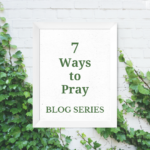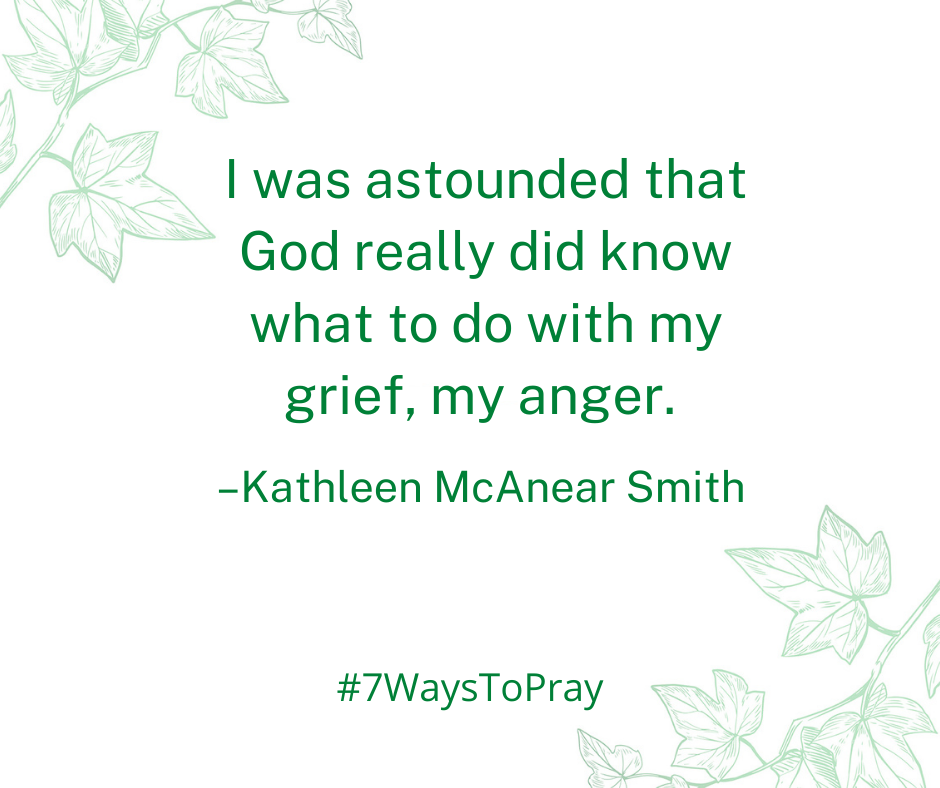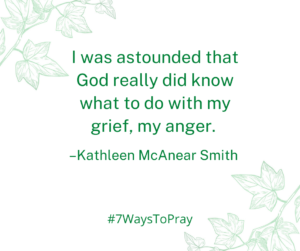“Learning to Trust Ancient Ways of Praying” by Kathleen McAnear Smith: 7 Ways to Pray blog series

I’m humbled by Kathleen’s wonderful post about how she’s come to pray with the ancient practices I outline in my book, 7 Ways to Pray. When writing I prayed so much that it would be a means of introducing some of these time-tested practices to people who might not only not have heard of them, but were suspicious of them. What a gift that God has used my book in her life in this way! Whether you’ve prayed in some of these ways for years or are not sure about them, I believe you’ll appreciate hearing more from her.

My particular Christian denomination used to pride itself on not—no, never—using set prayers. We wouldn’t touch traditional, handed-down-through-the-centuries prayers with anything but disdain. We were smug about it; superiorly smug in our thinking that prayer was just something you did off the top of your head. We were sure we knew all anyone needed to know about prayer.
Due to travel and relocating overseas I eventually changed denominations, but I happily managed to carry some of that attitude with me. Not for me were the stuffy old ways of prayer, I thought. I’ve had to work hard at staying closed-minded about the beautiful traditions of the ancient church, but denominational prejudice reigned well into my fifties.
That all changed on an unmentionable birthday when I blessed myself with attending a workshop on prayer. Truthfully, I didn’t pay much attention to the topic, I just wanted to hear the speaker, Amy Boucher Pye. She started the morning with an introduction to the concept of lectio divina. “Lectio what?” I said, remembering childhood teaching about the repetition of words that would put you to sleep. It turned out that not only did I stay awake, but as Amy introduced this new-to-me way of prayer something was coming alive in my spirit. I even acknowledged quietly to myself that often I had used Scripture to prove a point in discussion, just not considered the Word as a basis of praying.
Deciding to learn more, I attended one of Amy’s online retreats on lament. This was the year I lost a very precious relative and I was beside myself trying to figure out how to pray. Amy’s teaching on lament became art form powerfully pulling me closer to the King of Kings. She draws you in to the world, the history, and the creativity of prayer. In her book, 7 Ways to Pray Amy introduces the ancient ways in a way that intrigues and you just want to know more and experience more. I was astounded that God really did know what to do with my grief, my anger.
Yet, as I read this 7 Ways to Pray, I wondered “How can I trust these forms of prayer? What really is a lectio divina? Examen? Who is Ignatius? Won’t I just get bogged down in dark ages faith?” I pondered all this even as I was beginning to see changes in my prayer life. I needed assurance that while I had been taught to disregard tradition from the early days of my childhood, I was heading in a direction that pleased God. It’s hard to stand on tradition when you don’t believe in it.
In 7 Ways to Pray Amy faces these issues head on with clear guidance as to what prayer does in your life. Amy writes that prayer is meant to bring you closer to Jesus, and that when we pray, we see the “collaboration” and “uniting of our desires with the Holy Spirit”. This seems to be the test of a good prayer. In learning these ancient ways of prayer, you notice if you are coming closer to Jesus.
As you look at each chapter you are invited to see what draws you closer to your Lord. Creativity? Understanding of the Word of God? As someone who has never journeyed this way before, I found Amy’s writing to be a trusted friend as she shares her own experience of stepping into the ways of saints past who inspire the future. She writes to clarify, to enable the journey of others, not cloak in unrelatable mystery. I suggest you take 7 Ways to Pray and use it as a workbook. This is not a book to sit on a shelf. It’s to be used actively. Get your pencil, get your highlighters out and take note of what sparks your imagination. Write in the margins. Stick tabs on paragraphs that jump out at you. Have a go with one chapter, then the prayer in a next chapter. You will meet prayers that have been developed over the ages right down to this this age and see what happens.
While “top-of-your-head prayers” will always pop into daily life, I’m glad I’ve given myself the gift not only of the book 7 Ways to Pray, but the time in which to explore the ancient ways of prayer that Amy has made accessible even to a know-it-all like me.

Kathleen McAnear Smith just launched her website Global Grandmas. She is using what she learned in 7 Ways to Pray to enjoy the adventure of praying for her grandchildren as well as the wider family. Her book Beyond Broken Families encourages prayer for healing 21st century family life. This past year she was appointed as a Director of Families in Global Transition.
Order 7 Ways to Pray here, including in the US, UK, and Australia. You’ll also find lots of resources for small groups – videos and a leader’s guide – here.








 Hello!
Hello! 
